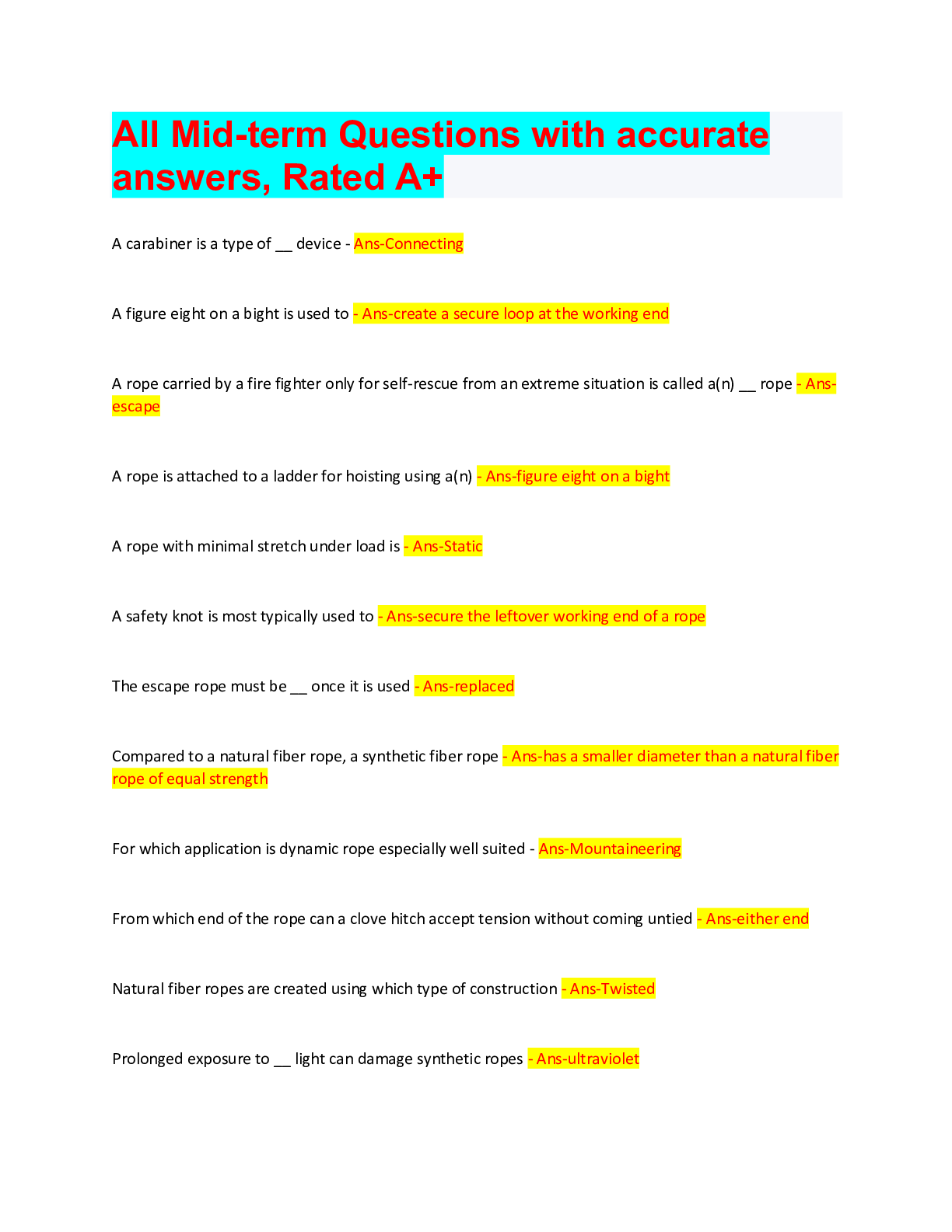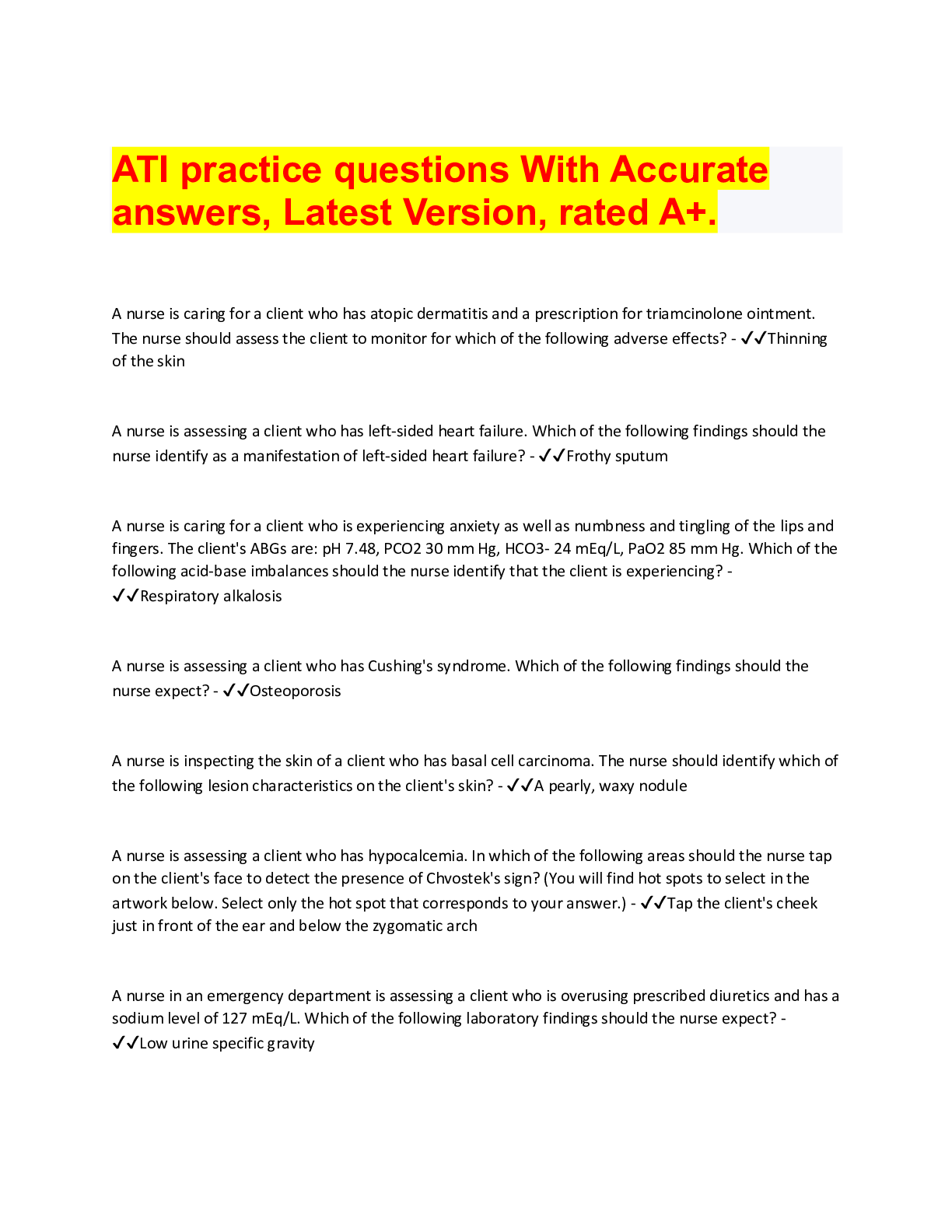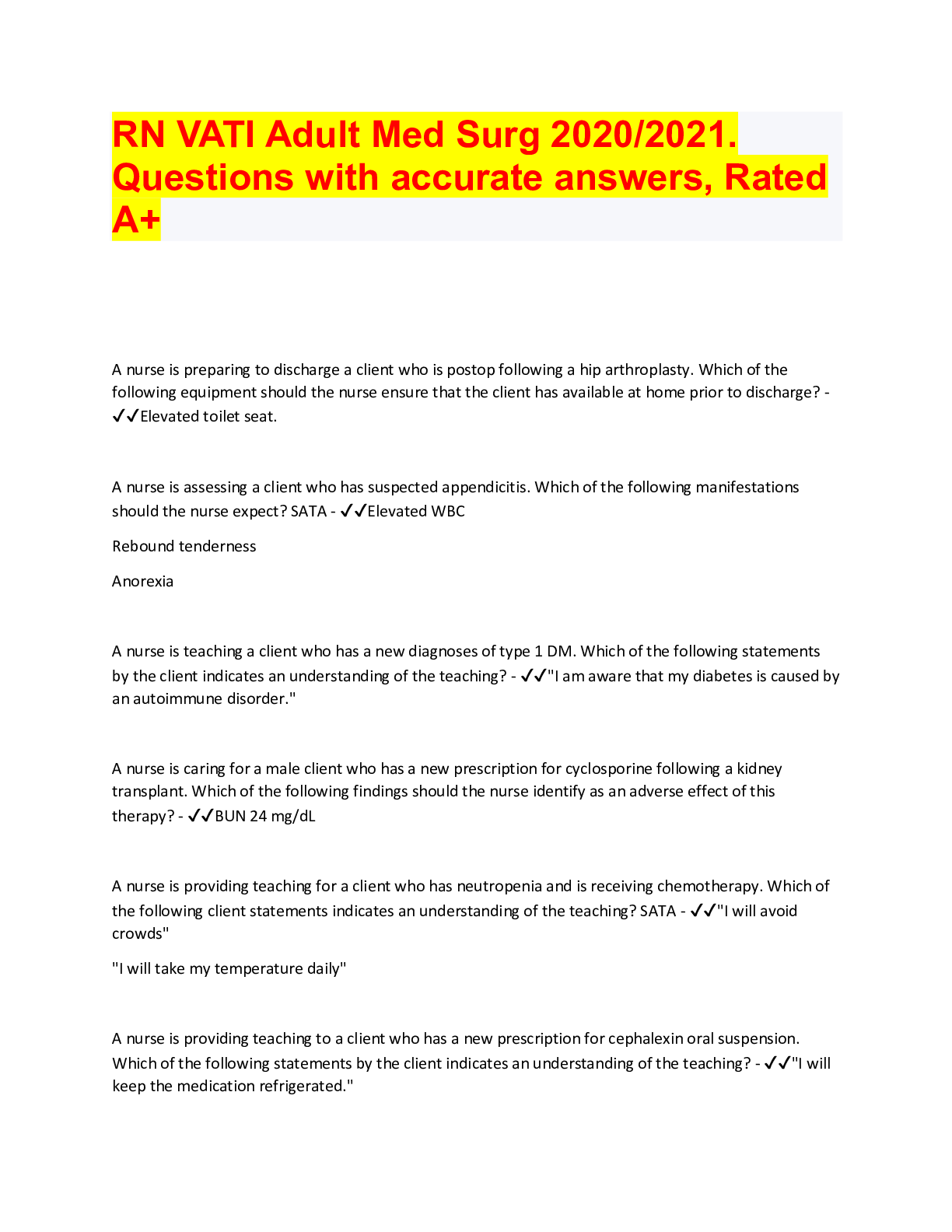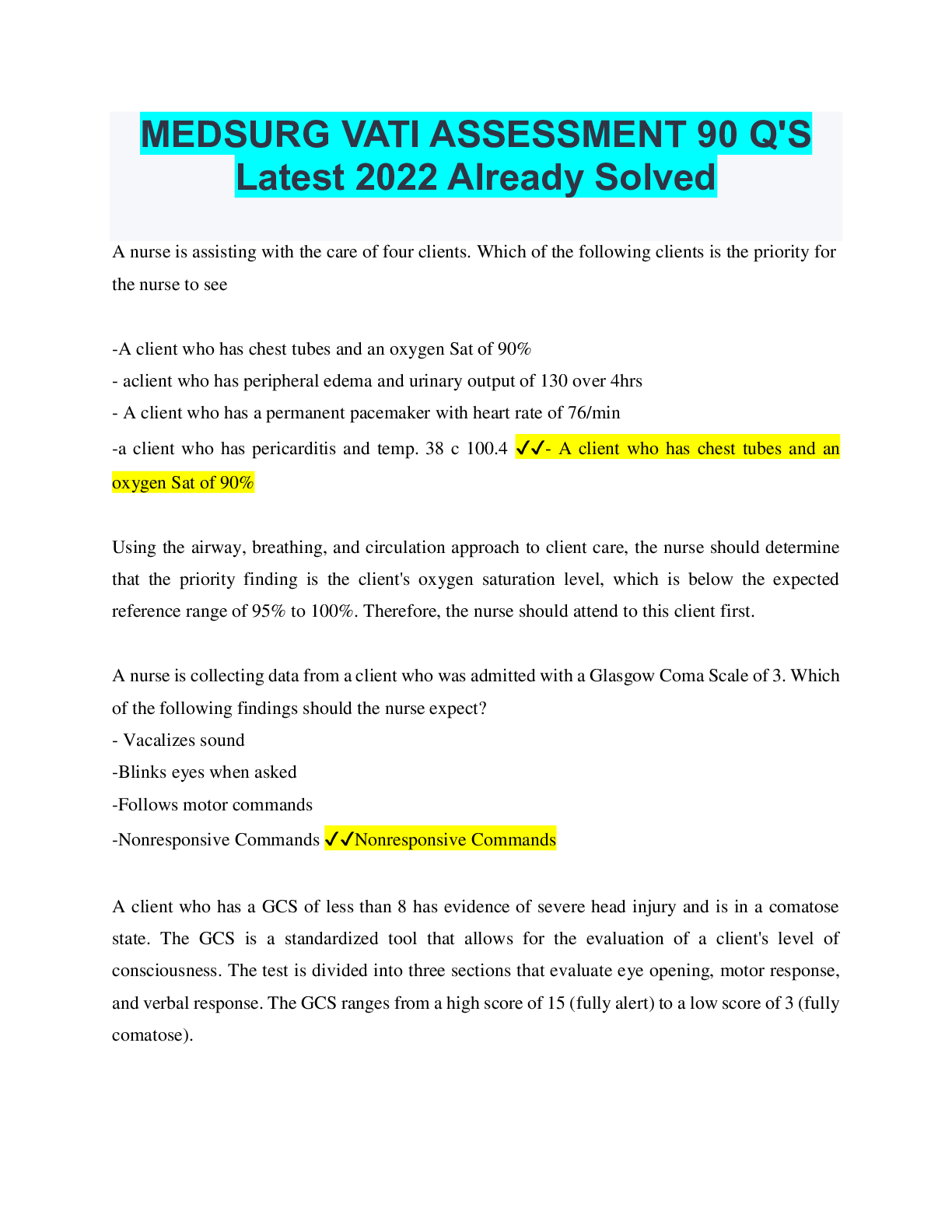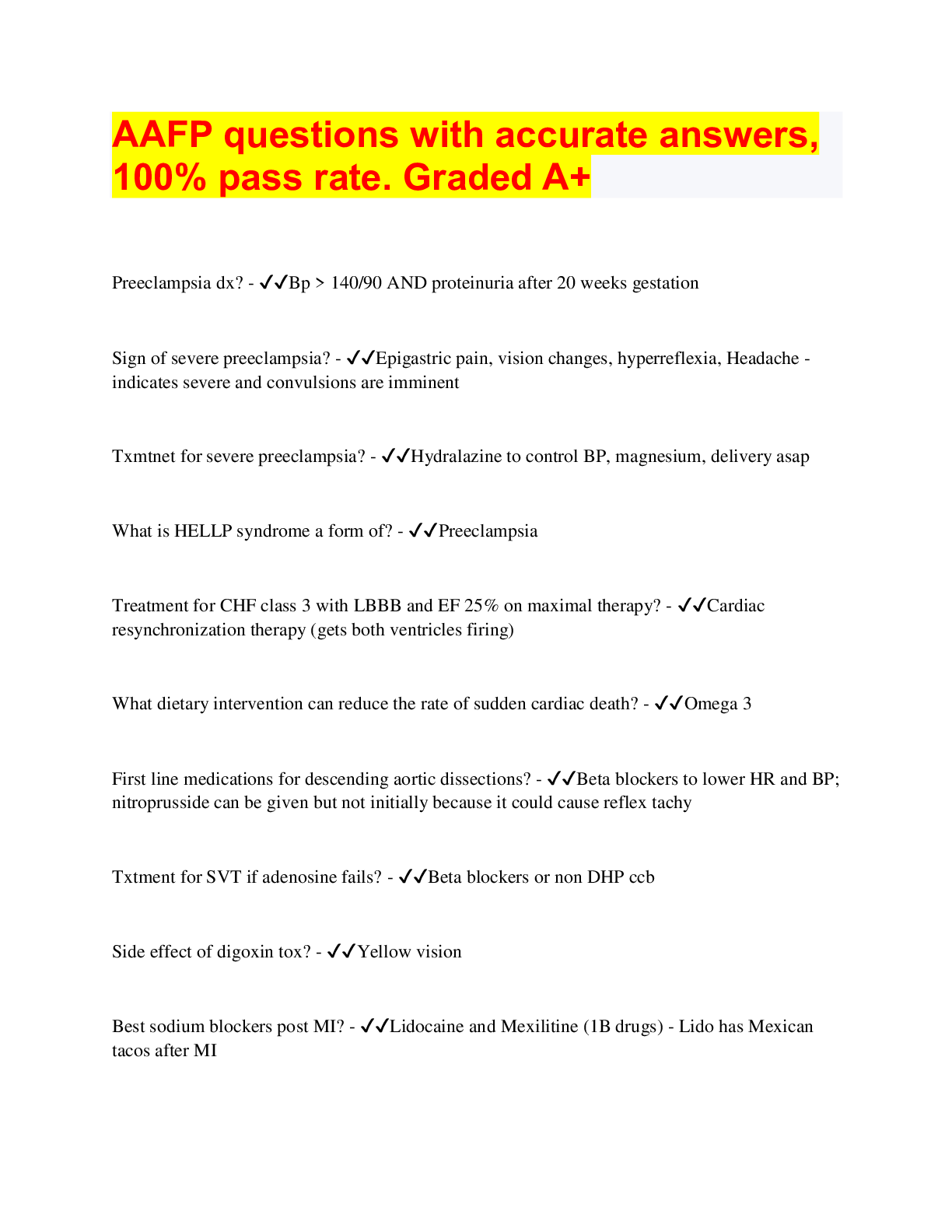*NURSING > QUESTIONS & ANSWERS > WK11/MN SUCCESS/CH.9 High-Risk Intrapartum questions with Accurate answers, 2022 (All)
WK11/MN SUCCESS/CH.9 High-Risk Intrapartum questions with Accurate answers, 2022
Document Content and Description Below
A client has been diagnosed with water intoxication after having received IV oxytocin (Pitocin) for over 24 hours. Which of the following signs/symptoms would the nurse expect to see? 1. Confusion,... drowsiness, and vomiting. 2. Hypernatremia and hyperkalemia. 3. Thrombocytopenia and neutropenia. 4. Paresthesias, myalgias, and anemia. - ✔✔1. These are the classic signs of water intoxication. The physician has ordered oxytocin (Pitocin) for induction for 4 gravidas. In which of the following situations should the nurse refuse to comply with the order? 1. Primigravida with a transverse lie. 2. Multigravida with cerebral palsy. 3. Primigravida who is 14 years old. 4. Multigravida who has type 1 diabetes. - ✔✔1. Induction is contraindicated in transverse lie. A client, 38 weeks' gestation, is being induced with IV oxytocin (Pitocin) for hypertension and oligohydramnios. She is contracting q 3 min × 60 to 90 seconds. She suddenly complains of abdominal pain accompanied by significant fetal heart bradycardia. Which of the following interventions should the nurse perform first? 1. Turn off the oxytocin infusion. 2. Administer oxygen via face mask. 3. Reposition the patient. 4. Call the obstetrician. - ✔✔1. Whenever there is marked fetal bradycardia and oxytocin is running, the nurse should immediately turn off the oxytocin drip. An induction of a 42-week gravida with IV oxytocin (Pitocin) is begun at 0900 at a rate of 0.5 milliunits per minute. The woman's primary physician orders: Increase the oxytocin drip by 0.5 milliunits per minute every 10 minutes until contractions are every 3 minutes × 60 seconds. The nurse refuses to comply with the order. Which of the following is the rationale for the nurse's action? 1. Fetal distress has been noted in labors when oxytocin dosages greater than 2 milliunits per minute are administered. 2. The relatively long half-life of oxytocin can result in unsafe intravascular concentrations of the drug. 3. It is unsafe practice to administer oxytocin intravenously to a woman who is carrying a postdates fetus. 4. A contraction duration of 60 seconds can lead to fetal compromise in a baby that is postmature. - ✔✔2. The practitioner should increase the dosage of oxytocin at a minimum time interval of every 30 minutes. A 40-week-gestation woman has received Cytotec (misoprostol) for cervical ripening. For which of the following signs/symptoms should the nurse carefully monitor the client? 1. Diarrhea and back pain. 2. Hypothermia and rectal pressure. 3. Urinary retention and rash. 4. Tinnitus and respiratory distress. - ✔✔1. A common side effect of Cytotec is diarrhea and labor contractions are often first felt in the back. A woman, G3 P1010, is receiving oxytocin (Pitocin) via IV pump at 3 milliunits/min. Her current contraction pattern is every 3 minutes × 45 seconds with moderate intensity. The fetal heart rate is 150 to 160 bpm with moderate variability. Which of the following interventions should the nurse take at this time? 1. Stop her infusion. 2. Give her oxygen. 3. Change her position. 4. Monitor her labor. - ✔✔4. It is appropriate to monitor the woman's labor. A woman is to receive Prepidil (dinoprostone gel) for labor induction. The nurse should be prepared to administer the medication via which of the following routes? 1. Intravenously. 2. Orally. 3. Endocervically. 4. Intrathecally. - ✔✔3. Prepidil is administered endocervically. A woman, 402⁄7 weeks' gestation, has had ruptured membranes for 15 hours with no labor contractions. Her obstetrician has ordered 10 units oxytocin (Pitocin) to be diluted in 1,000 mL D51⁄2 NS. The order reads: Administer oxytocin IV at 0.5 milliunits per min. Calculate the drip rate for the infusion pump to be programmed. Please calculate to the nearest whole number. __________ mL/hr. - ✔✔3 mL/hr. The nurse turns off the oxytocin (Pitocin) infusion after a period of hyperstimulation. Which of the following outcomes indicates that the nurse's action was effective? 1. Intensity moderate. 2. Frequency every 3 minutes. 3. Duration 130 seconds. 4. Attitude flexed. - ✔✔2. A frequency pattern of every 3 minutes is ideal. A nurse is monitoring the labor of a client who is receiving IV oxytocin (Pitocin) at 6 mL per hour. Which of the following clinical signs would lead the nurse to stop the infusion? 1. Change in maternal pulse rate from 76 to 98 bpm. 2. Change in fetal heart rate from 128 to 102 bpm. 3. Maternal blood pressure of 150/100. 4. Maternal temperature of 102.4°F. - ✔✔2. The baseline fetal heart rate has dropped over 20 bpm. This finding warrants that the oxytocin be stopped. A primigravid client received Cervidil (dinoprostone) for induction 8 hours ago. The Bishop score is now 10. Which of the following actions by the nurse is appropriate? 1. Perform nitrazine analysis of amniotic fluid. 2. Report abnormal findings to the obstetrician. 3. Place woman on her side. 4. Monitor for onset of labor. - ✔✔4. The nurse should monitor this client for the onset of labor. The physician has ordered Prepidil (dinoprostone) for four gravidas at term. The nurse should question the order for which of the women? 1. Primigravida with Bishop score of 4. 2. Multigravida with late decelerations. 3. G1 P0000 contracting every 20 minutes × 30 seconds. 4. G6 P3202 with blood pressure 140/90 and pulse 92. - ✔✔2. This client's fetus is already showing signs of fetal distress. Induction increases the risk of fetal injury. A client, G4 P1021, has been admitted to the labor and delivery suite for induction of labor. The following assessments have been made: Bishop score of 2, fetal heart rate of 156 with good variability and no decelerations, TPR 98.6°F, P 88, R 20, BP 120/80, negative obstetric history. Cervidil (dinoprostone) has been inserted. Which of the following findings would warrant the removal of the prostaglandin? 1. Bishop score of 4. 2. Fetal heart rate of 152. 3. Respiratory rate of 24. 4. Contraction frequency of 1 minute. - ✔✔4. A contraction frequency of 1 minute, even with a short duration, would warrant the removal of the medication. There are four clients in active labor in the labor suite. Which of the women should the nurse monitor carefully for the potential of uterine rupture? 1. Age 15, G3 P0020, in active labor. 2. Age 22, G1 P0000, eclampsia. 3. Age 25, G4 P3003, last delivery by cesarean section. 4. Age 32, G2 P0100, first baby died during labor. - ✔✔3. A woman, no matter what her age, who has had a previous cesarean section is at risk for uterine rupture. A client is admitted in labor with spontaneous rupture of membranes 24 hours earlier. The fluid is clear and the fetal heart rate is 124 with moderate variability. Which assessment is most important for the nurse to make at this time? 1. Contraction frequency and duration. 2. Maternal temperature. 3. Cervical dilation and effacement. 4. Maternal pulse rate. - ✔✔2. Maternal temperature is the highest priority. A client, 39 weeks' gestation, fetal heart baseline at 144 bpm, tells the admitting labor and delivery room nurse that she has had to wear a pad for the past 4 days "because I keep leaking urine." Which of the following is an appropriate action for the nurse to perform at this time? 1. Palpate the woman's bladder to check for urinary retention. 2. Obtain a urine culture to check for a urinary tract infection. 3. Assess the fluid with nitrazine and see if the paper turns blue. 4. Percuss the woman's uterus and monitor for ballottement. - ✔✔3. The fluid should be assessed with nitrazine paper. The nurse is to intervene when caring for a laboring client whose baby is exhibiting signs of fetal distress. Which of the following actions should the nurse take? 1. Administer oxygen via nasal cannula. 2. Place the client in high Fowler's position. 3. Remove the internal fetal monitor electrode. 4. Increase the intravenous infusion rate. - ✔✔4. Increasing the IV rate helps to improve perfusion to the placenta. Four women request to labor in the hospital bathtub. In which of the following situations is the procedure contraindicated? Select all that apply. 1. Woman during transition. 2. Woman during second stage of labor. 3. Woman receiving oxytocin for induction. 4. Woman with meconium-stained fluid. 5. Woman with fetus in the occiput posterior position. - ✔✔3 and 4 are correct. 3. Women undergoing induction should not labor in a water bath. During induction, the fetus should be monitored continually by electronic fetal monitoring. 4. Meconium-stained amniotic fluid may indicate fetal distress. Continuous electronic fetal monitoring would, therefore, be indicated. A full-term client, contracting every 15 min × 30 sec, has had ruptured membranes for 20 hours. Which of the following nursing interventions is contraindicated at this time? 1. Intermittent fetal heart auscultation. 2. Vaginal examination. 3. Intravenous fluid administration. 4. Nipple stimulation. - ✔✔2. Vaginal examination is contraindicated. A woman, 39 weeks' gestation, is admitted to the delivery unit with vaginal warts from human papillomavirus. Which of the following actions by the nurse is appropriate? 1. Notify the health care practitioner for a surgical delivery. 2. Follow standard infectious disease precautions. 3. Notify the nursery of the imminent delivery of an infected neonate. 4. Wear a mask whenever the perineum is exposed. - ✔✔2. Standard precautions are indicated in this situation. A client telephones the labor and delivery suite and states, "My bag of waters just broke and it smells funny." Which of the following responses would be appropriate for the nurse make at this time? 1. "Have you notified your doctor of the smell?" 2. "The bag of waters always has an unusual odor." 3. "Your labor should start very soon." 4. "Have you felt the baby move since the membranes broke?" - ✔✔4. The most important information needed by the nurse should relate to the health and well-being of the fetus. Fetal movement indicates that the baby is alive. A client, G3 P2002, 40 weeks' gestation, who has vaginal candidiasis, has just been admitted in early labor. Which of the following should the nurse advise the woman? 1. She may need a cesarean delivery. 2. She will be treated with antibiotics during labor. 3. The baby may develop thrush after delivery. 4. The baby will be isolated for at least one day. - ✔✔3. Thrush is the term given to oral candidiasis, which the baby may develop after delivery. A woman who is hepatitis B-surface antigen positive is in active labor. Which action by the nurse is appropriate at this time? 1. Obtain an order from the obstetrician to prepare the client for cesarean delivery. 2. Obtain an order from the obstetrician to administer intravenous ampicillin during labor and the immediate postpartum. 3. Obtain an order from the pediatrician to administer hepatitis B immune globulin and hepatitis B vaccine to the baby after birth. 4. Obtain an order from the pediatrician to place the baby in isolation after delivery. - ✔✔3. Within 12 hours of birth, the baby should receive both the first injection of hepatitis B vaccine and HBIG. A client has just entered the labor and delivery suite with ruptured membranes for 2 hours, fetal heart rate of 146, contractions every 5 minutes × 60 seconds, and a history of herpes simplex type 2. She has no observable lesions. After notifying the doctor of the admission, which of the following is the appropriate action for the nurse to take? 1. Check dilation and effacement. 2. Prepare the client for surgery. 3. Place the bed in Trendelenburg position. 4. Check the biophysical profile results. - ✔✔1. It is appropriate for the nurse to assess the client's dilation and effacement. Immediately prior to an amniotomy, the external fetal heart monitor tracing shows 145 bpm with early decelerations. Immediately following the procedure, an internal tracing shows a fetal heart rate of 120 with variable decelerations. A moderate amount of clear, amniotic fluid is seen on the bed linens. The nurse concludes that which of the following has occurred? 1. Placental abruption. 2. Eclampsia. 3. Prolapsed cord. 4. Succenturiate placenta. - ✔✔3. The drop in fetal heart rate with variable decelerations indicates that the cord has likely prolapsed. Immediately after a woman spontaneously ruptures her membranes, the nurse notes a loop of the umbilical cord protruding from the woman's vagina. Which of the following actions should the nurse perform first? 1. Put the client in the knee-chest position. 2. Assess the fetal heart rate. 3. Administer oxygen by tight face mask. 4. Telephone the obstetrician with the findings. - ✔✔1. The first action the nurse should take is to place the woman in the knee-chest position. A client just spontaneously ruptured membranes. Which of the following factors makes her especially at high risk for having a prolapsed cord? Select all that apply. 1. Breech presentation. 2. Station -3. 3. Oligohydramnios. 4. Dilation 2 cm. 5. Transverse lie. - ✔✔1, 2, and 5 are correct. 1. When a baby is in the breech presentation, there is increased risk of prolapsed cord. 2. The presenting part is floating, which increases the risk of prolapsed cord. 5. When a baby is in the transverse lie, there is increased risk for prolapsed cord. A nurse is caring for four clients on the labor and delivery unit. Which of the following actions should the nurse take first? 1. Check the blood sugar of a gestational diabetic. 2. Assess the vaginal blood loss of a client who is post-spontaneous abortion. 3. Assess the patellar reflexes of a client with mild preeclampsia. 4. Check the fetal heart rate of a client who just ruptured membranes. - ✔✔4. The priority action for this nurse is to assess the fetal heart rate of a client [Show More]
Last updated: 1 year ago
Preview 1 out of 42 pages
Instant download

Buy this document to get the full access instantly
Instant Download Access after purchase
Add to cartInstant download
Reviews( 0 )
Document information
Connected school, study & course
About the document
Uploaded On
Aug 13, 2022
Number of pages
42
Written in
Additional information
This document has been written for:
Uploaded
Aug 13, 2022
Downloads
0
Views
61












